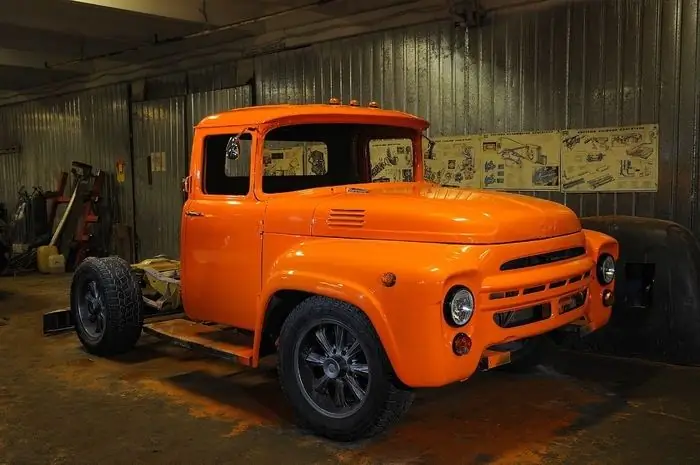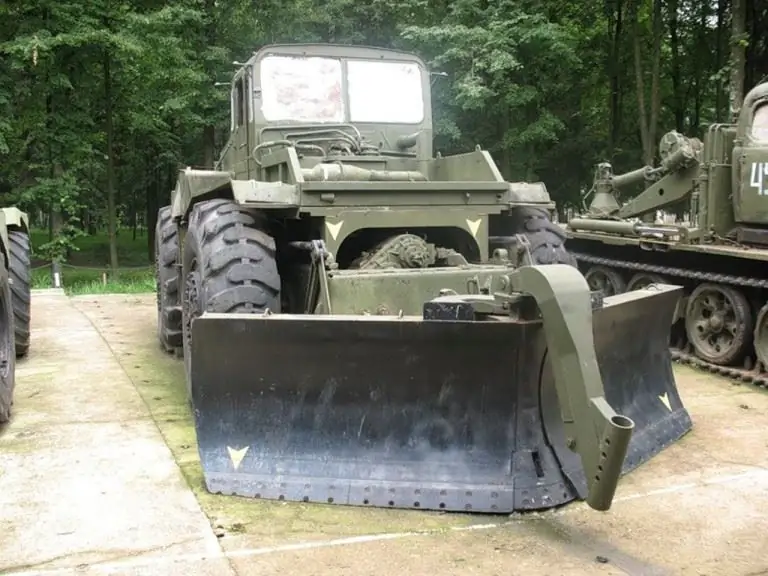2026 Author: Erin Ralphs | [email protected]. Last modified: 2025-06-01 05:35:55
GAZ-AAA - the car that became the most massive three-axle pre-war truck model not only in the USSR, but throughout the world. We will talk about it later in the article.

American brother of the Soviet "three-axle"
It is sad to admit, but the prototype of Soviet trucks, put on three axles, is the American car Ford-Timken. It is worth noting that in the United States, cars of this class, characterized by increased cross-country ability, were not popular, but in the USSR, where off-road problems never lost their relevance, such trucks were very useful. Therefore, since 1931, the Gudok Oktyabrya plant, located in Nizhny Novgorod (later renamed the city of Gorky), began to manufacture domestic copies of Timkens from components supplied from America.
It is clear that this could not go on for a long time - the Land of the Soviets needed its own car.
"Trehosnik" from Gorky
In 1932, the Moscow NATI designed the "trehoska", taking again the American Ford AA as the base, which had previously served as the prototype of the GAZ-AA ("one and a half"). After that, the results of work on the car were transferred to GAZ forfull fine-tuning, before release into the series.
V. Grachev, the most talented designer of the Gorky Automobile Plant, was entrusted with finishing the GAZ-AAA, but even he managed to put a new truck on the conveyor (in 1934) only the third time. Each time, the design of the undercarriage of a new car began from scratch. The third axle, which they simply tried to fit into an existing lorry, categorically refused to take root there.

Nevertheless, it should be noted that two samples of GAZ-AAA, preceding the production model, took part in the Karakum run in 1933.
As a result, the designers nevertheless achieved the desired result, and the car went into mass production. And despite the fact that outwardly the GAZ-AAA differed from the "one and a half" only in the third axle, it was already a different car.
The difference between the new "three-wheeler" and the old "one-and-a-half"
First of all, it should be noted that the new truck received a different frame. Since the engine was now subjected to higher loads, it became necessary to improve the cooling system, so the four-row radiator from GAZ-AA was replaced with a six-row one and a four-bladed fan was also installed. Thus, the radiator core has increased in thickness by 37 mm.
If on the “lorry” the spare wheel was suspended in the rear, under the frame, then GAZ-AAA, firstly, had two spare wheels, and secondly, they were transferred directly under the body, where they were fixed on folding brackets. The designers also installed a tool box there. Causesuch a change was the crankcase of the rear axle bogie, which did not allow the "reserve" ("reserve") to be fixed in the traditional place. The body itself, in order to prevent the wheels of the rear bogie of its body from touching while driving off-road, was raised by ten centimeters, and its supporting transverse bars were increased in diameter to increase strength due to the increase in the carrying capacity of the machine.
Besides, in 1937, the three-axle Soviet truck GAZ began to be equipped with a more powerful engine (50 hp) instead of the old forty-horsepower one. The secondary shaft of the demultiplier was equipped with a disc brake, and the car also received an additional fuel tank with a capacity of 60 liters. The body was expanded by 10 cm and reinforced with a metal frame.

GAZ-AAA specifications looked like this:
- machine dimensions (m) - 5.335 x 2.04 x 1.97 (length, width, height);
- curb weight (t) - 2,475;
- cabin capacity - 2 people;
- carrying capacity (t) - 2;
- wheel formula - 6 by 2;
- machine base (m) - 3, 2;
- wheel track (m) - 1, 405;
- power of the power unit (hp) - 504;
- gasoline consumption - 27 liters per 100 km;
- speed limit is 65 km/h.
Practical application of the "trihoski"
GAZ-AAA - a model that was primarily intended for the army. There, these vehicles were used mainly for transporting personnel and cargo. As a tractor for art. armament "trehoska" was not good,because it didn't have enough power. However, these trucks were perfect for mounting quad machine gun mounts or 37mm anti-aircraft guns.

In addition, on the basis of GAZ-AAA, a self-propelled gun SU-1-12 with a 76-mm cannon, armored vehicles of the middle class BA-6 and BA-10, repair vehicles PARM and PM "type A", radio station RSBF, as well as a variety of vans, tanks, movie vans, propaganda buses and fire trucks.
End of assembly line life
In 1943, the Gorky Automobile Plant was bombed by German aircraft and was actually destroyed. For the first time in the entire war, GAZ was forced to stop its work.
Despite the problems associated with wartime, the company was quickly restored and continued to produce much-needed cars for the country at war. However, after the reconstruction, the production of GAZ-AAA was discontinued. And the role of a two-ton truck with increased cross-country ability after the end of the war began to play a two-axle, equipped with all-wheel drive, GAZ-63.
In total, since 1934, 37,373 cars have been produced by the Gorky people. Of these, only three copies have survived to this day.
Recommended:
ZIL-pickup: description with photo, specifications, history of creation

ZIL-pickup car: history of creation, interesting facts, characteristics, features, modifications, photos. Pickup truck based on ZIL: description, restoration, tuning. Converting ZIL-130 into a pickup truck: recommendations, details, how to do it yourself
Honda CBR1100XX: description, history, specifications

Honda CBR1100XX was released in 1996. At that time, he immediately took a leading position in speed, but later, focusing more on sports tourism, the manufacturer gave way to Kawasaki and Suzuki, which achieved higher speed performance
Wheel tractor MAZ-538: description, specifications, purpose and history of creation

Wheel tractor MAZ-538: description, history of creation, design features, photo. MAZ-538: technical characteristics, purpose, device, type of suspension, engine and gearbox
Sportbike Suzuki GSX-R 1000: description, specifications, model history

The history of Suzuki GSX-R 1000 sports motorcycles begins in 2001, when the mass production of this model was launched. Today, the motorcycle is considered the flagship of Suzuki and the most modern sports class motorcycle that combines innovative racing technologies
GAZ-63 is a Soviet truck. History, description, specifications

Despite the fact that not only many years have passed since the start of production of the GAZ-63, but it was also discontinued almost half a century ago, this truck can still be seen on the roads. He even participates in sports competitions. This army all-wheel drive truck did not participate in the Great Patriotic War, but it earned the recognition of the military and deserves to be remembered

